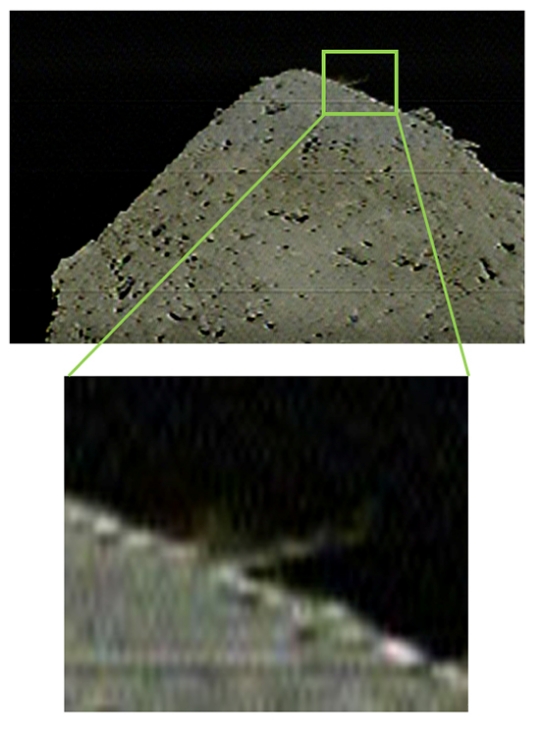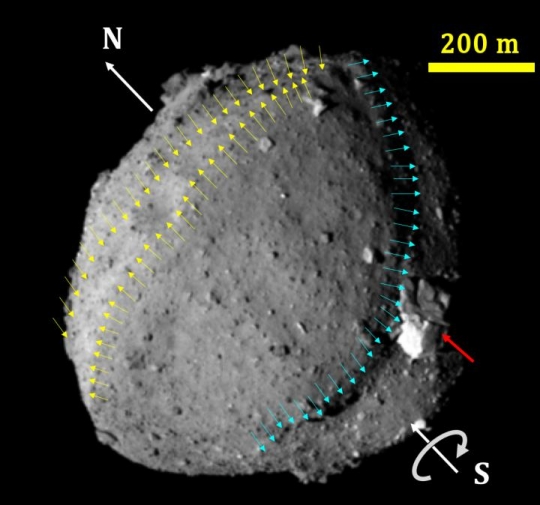Putting a crater on an asteroid is no small matter, for it allows us to gather samples to further nail down the object’s composition. The Japan Aerospace Exploration Agency (JAXA) has achieved the feat on asteroid Ryugu using the Small Carry-on Impactor (SCI) carried by the Hayabusa2 spacecraft. Confirmation of the crater and details about its size will be forthcoming, but fortunately the spacecraft’s DCAM3 camera was able to record the event.
Following Hayabusa2 on Twitter (@haya2e_jaxa) is often the best way to keep up with operations at Ryugu (even as @OSIRISREx puts you inside that mission). The fact that we have two spacecraft in current operations around asteroids should be cause for continuing celebration. From the Hayabusa2 Twitter feed:
[SCI] The deployable camera, DCAM3, successfully photographed the ejector from when the SCI collided with Ryugu’s surface. This is the world’s first collision experiment with an asteroid! In the future, we will examine the crater formed and how the ejector dispersed. pic.twitter.com/eLm6ztM4VX
— HAYABUSA2@JAXA (@haya2e_jaxa) April 5, 2019
And with a closer look plus JAXA caption:

Image: This image captured by the camera separated from Hayabusa2 (DCAM3) shows ejection from Ryugu’s surface, which was caused by the collision of the SCI against Ryugu. Image taken at 11:36 a.m., April 5, 2019 (Indicated by the camera, Japan time). Credit: JAXA, Kobe University, Chiba Institute of Technology, The University of Occupational and Environmental Health, Kochi University, Aichi Toho University, The University of Aizu, and Tokyo University of Science.
The spacecraft protected itself before impact by moving to the other side of Ryugu to avoid any debris stirred by the collision. And while Hayabusa2 has already gathered one sample from the asteroid’s surface, the material gathered as a result of the impact should give scientists the opportunity to study what is below the surface, pristine material that dates back to the early days of the Solar System. Sample return is currently scheduled for late 2020.
As to the asteroid’s composition, the early data from Hayabusa2 have already proven useful. Says Seiji Sugita (University of Tokyo), author of a recent paper on the asteroid:
“Just a few months after we received the first data we have already made some tantalising discoveries. The primary one being the amount of water, or lack of it, Ryugu seems to possess. It’s far dryer than we expected, and given Ryugu is quite young (by asteroid standards) at around 100 million years old, this suggests its parent body was much largely devoid of water too.”

Image: Ryugu is a C-type asteroid — rich in carbon — about 900m wide. Credit: © 2019 Seiji Sugita et al., Science.
In a March 19 news conference, Sugita told an audience at the Lunar and Planetary Science Conference that Ryugu is now thought to be a fragment of one of two more distant asteroids, Eulalia or Polana. The breakup is thought to have occurred 700 million years ago. The best match in color — Ryugu is an extremely dark object — is with these two main belt asteroids, with the scientist pegging the likelihood of the relationship as high as 90 percent.
Both the visible-light camera and a near-infrared spectrometer aboard the spacecraft confirm the dearth of water, a significant result given that asteroids are thought to have supplied water to the early Earth, along with comets as well as the circumstellar disk of the system itself. Ryugu’s meager water stands in contrast to what OSIRIS-REx has found at asteroid Bennu. Although both asteroids appear similar, covered in boulders and presenting challenges to lander missions, Bennu contains considerably more water.
The paper examines a range of possibilities to explain this, but concludes that the general uniformity in color across Ryugu’s surface points to a parent asteroid that experienced internal heating caused by radioactive decay of Aluminium-26. As the authors note: “Internal heating can warm a large fraction of the volume of the parent body relatively uniformly, leaving a small volume of outer layer relatively cool.” The paper continues:
Although multiple scenarios for the evolution of Ryugu’s parent body remain viable, our comparison between Hayabusa2 remote-sensing data, meteoritic samples and asteroids leads us to prefer the scenario of parent-body partial dehydration due to internal heating. This scenario suggests that asteroids that accreted materials which condensed at ?150 K (the H2O condensation temperature under typical solar nebula conditions) must have either formed early enough to contain high concentrations of radiogenic species, such as 26Al, or formed close to the Sun where they experienced other heating mechanisms). The degree of internal heating would constrain the location and/or timing of the snow line (i.e., the dividing line between H2O condensation and evaporation) in the early Solar System.
Thus the different traits of seemingly similar asteroids like Ryugu and Bennu offer plentiful ground for studying the astrophysical processes that shaped each. The paper is Sugita et al., “The geomorphology, color, and thermal properties of Ryugu: Implications for parent-body processes,” Science 19 March 2019 (abstract).



Water is likely to be an important consideration for asteroid mining (assuming it eventually occurs) as it provides both a resource to sell and a to use to reduce propellant mass. Careful characterization of asteroids will be needed in advance before mining starts. If the different water fractions of Ryugu and Bennu can only be determined locally, rather than remotely, this suggests that time and costs of physical exploration and prospecting will be needed. Pure spectrographic analysis from Earth orbit will be insufficient to make this determination unless some proxy can be used.
Jason Davis • April 4, 2019
Hayabusa2 Safe and Sound after Blasting New Crater on Ryugu
Hayabusa2 is safe and sound after successfully using its explosive-packed SCI experiment to create an artificial crater on Ryugu. JAXA released images from DCAM3, the small camera Hayabusa2 left behind to monitor the explosion and crater formation, that show a cloud of debris spraying into space.
http://www.planetary.org/blogs/jason-davis/hayabusa2-safe-after-sci.html
I look forward to the results of the differences between the surface and below surface compositions, especially that of the carbon molecules.
Jaxa has certainly earned points for audacity. Osiris Rex is a cautious slow and staid mission by comparison. The SCI shaped charge contained 4.5 kg HMX which has the explosive power of a modern anti-tank mine. Although DART will impact Didymoon with 1800 times the kinetic energy, it’s more like a guided missile to Hayabusa’s hand grenade.
In terms of the sampling of “pristine” or fresh subsurface material, given the loose nature of Ryugu’s surface as witnessed in the video of sample extraction 1(tantalum bullet), I’m guessing that subsurface composition will be very similar to that of the currently exposed surface. ie historical impacts will have homogenized the surface to a significant depth.
Hayabusa 2 is indeed an amazing mission. If the entire vessel stopped transmitting tomorrow, it would still have done incredible things compared to most other deep space probe missions.
Hayabusa 1 should also get props in consideration how it did so many firsts, came close to failure almost every time, and still got back to Earth with a few planetoid surface samples.
Is anyone going to check if the “impact” has
altered the future trajectory of Ryugu ??
I’m assuming that that would be an objective
of this mission ..
Triff ..
Someone with math and physics skills needs to calculate what it would take to push it and by how much. Or is Ryugu such a rubble pile that it might come apart depending upon how much force is used?
Let us not assume that Hayabusa 2 just pushed towards Earth, please. Some very non-astronomical types had this fear regarding Deep Impact when it bombed that comet in 2005. NASA said it was equivalent to a fly hitting a 747. Not that it probably swayed or soothed them, though, if Flat Earthers are any comparison.
April 25, 2019
Japan creates first artificial crater on asteroid
Japanese scientists have succeeded in creating what they called the first-ever artificial crater on an asteroid, a step towards shedding light on how the solar system evolved, the country’s space agency said Thursday.
The announcement comes after the Hayabusa2 probe fired an explosive device at the Ryugu asteroid early this month to blast a crater in the surface and scoop up material, aiming to reveal more about the origins of life on Earth.
Yuichi Tsuda, Hayabusa2 project manager at the Japanese space agency (JAXA), told reporters they confirmed the crater from images captured by the probe located 1,700 metres (5,500 feet) from the asteroid’s surface.
Full article here:
https://phys.org/news/2019-04-japan-artificial-crater-asteroid.html
Jason Davis • June 4, 2019
Hayabusa2 drops second target marker, targets artificial crater for sample collection
Japan’s Hayabusa2 spacecraft has successfully dropped a second target marker on Ryugu. The reflective softball-sized sphere, which contains the names of Planetary Society members and other supporters, will give the spacecraft a visual guide if mission planners send it back to the surface to attempt a second sample collection.
JAXA is now considering collecting the sample directly from the area where Hayabusa2 created an artificial crater in early April, thanks to updated imagery collected during an aborted touchdown marker drop attempt in mid-May.
http://www.planetary.org/blogs/jason-davis/hayabusa2-drops-second-tm.html